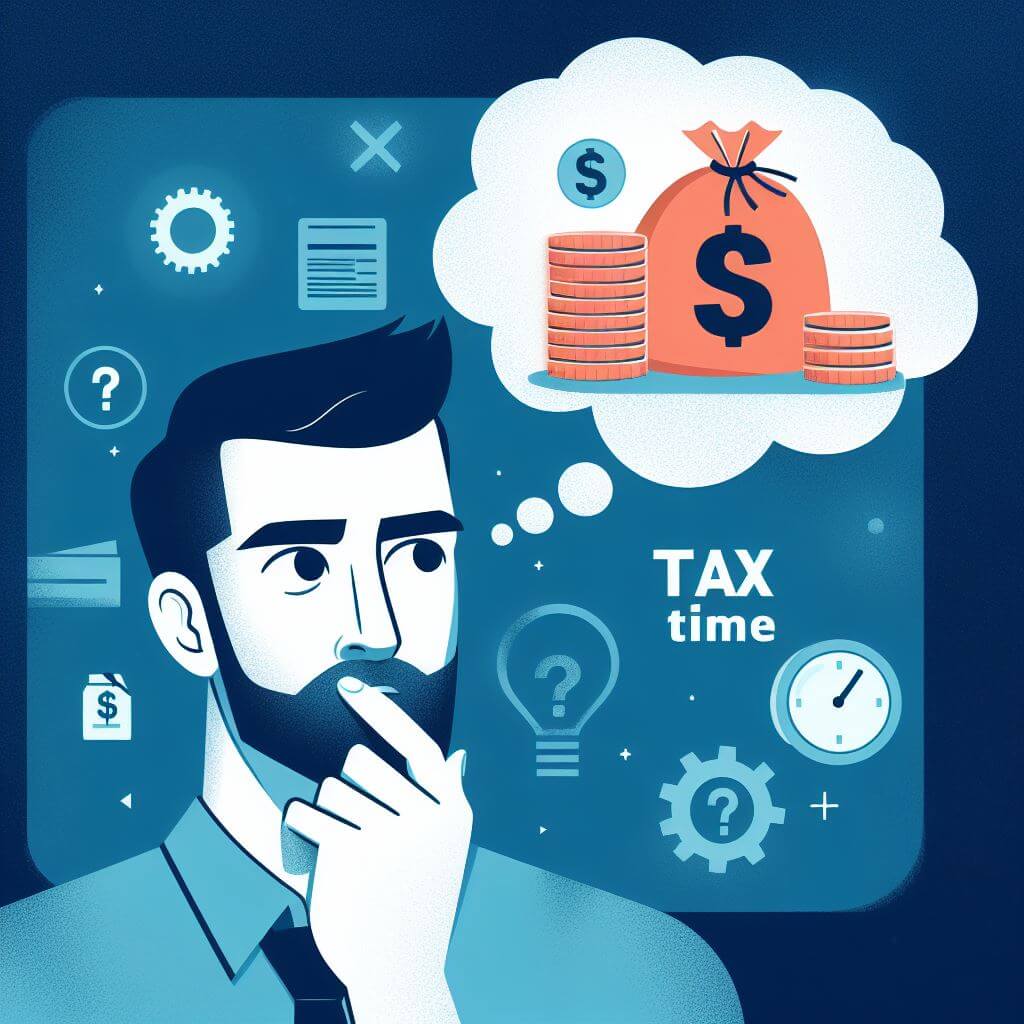What Can I Claim On Tax
Last Updated on 4 February 2024 by Ryan Oldnall
Tax time doesn’t have to be stressful! If you’ve ever wondered, “What can I claim on tax?” you’ve come to the right place. We will go through the 5 biggest tax deductions you might be able to use at Tax time.
We’ve developed a thorough overview of the tax deductions available to you. From work-related costs to investment income deductions, we’ll explore the ins and outs of claiming what’s rightfully yours on your tax return.
Let’s dive into the world of tax deductions in Australia and empower you to make the most of your hard-earned money.
Work From Home Deductions:
During the Covid pandemic, the Australian Government introduced a simplified “shortcut method” for claiming work from home deductions, providing a flat rate of 80 cents per work hour.
This temporary measure covered phone, data, and internet expenses, as well as the decline in equipment, furniture, and energy costs.
However, for the 2023 tax year, the Government has reverted to two methods: the ‘revised fixed rate method’ and the ‘actual cost method’.
To be eligible for a deduction for work from home expenses, you must:
- Incur additional running expenses directly related to your remote work
- Fulfill your employment duties from home
- Keep accurate records of the expenses incurred during your work hours.
You can only claim the revised fixed rate method and actual cost method for the portion of your working day that corresponds to work-related expenses.
Revised Fixed Rate Method
Working from home has become the new norm for many of us, and the Australian Government has introduced the revised fixed rate method to simplify claiming expenses.
Let’s explore how this method can help you maximize your deductions:
- Flat rate: With the revised fixed rate method, you can claim a flat rate of 67 cents per hour for every hour you work from home. No need for complex calculations or extensive record-keeping!
- No dedicated home office required: Unlike other methods, the revised fixed rate doesn’t require you to have a dedicated home office. You can claim the rate regardless of your workspace setup.
- Expenses covered: The revised fixed rate includes a comprehensive range of expenses, such as:
- Data and Internet costs
- Mobile and home phone usage
- Electricity and gas bills
- Computer consumables (e.g., printer ink)
- Stationery
- This means that you will not be able to claim these items separately
- Additional deductions: While the fixed rate method simplifies many claims, you can still claim separate deductions for:
- The decline in value of assets used while working from home (e.g., computers and office furniture)
- Repairs and maintenance of these assets
- Cleaning expenses (applicable if you have a dedicated home office)
- Record-keeping: Ensure you keep accurate records of your work hours and any expenses incurred during your remote work to support your claims.
The ATO may ask you to prove how you determined your work from home hours if you were ever audited.
Actual Cost Method
If you prefer a more detailed approach to claiming work from home expenses, the actual cost method might be your ideal choice.
This method allows you to claim a deduction for the exact expenses you incur while working from home. Let’s dive into the specifics of how the actual cost method works:
- Comprehensive expenses: With the actual cost method, you have the flexibility to claim deductions for each of the expenses incurred, such as:
- Data and Internet expenses
- Mobile and home phone usage
- Electricity and gas bills
- Computer consumables (e.g., printer ink)
- Stationery
- The decline in value of assets used while working from home (e.g., computers and office furniture)
- Maintenance and repairs of these assets
- Cleaning expenses (if you have a dedicated home office)
Detailed calculations and records: Utilizing the actual cost method requires accurate calculations and thorough record-keeping. For instance, you’ll need to keep track of the cost per unit of electricity and the average units used per hour to accurately claim the deduction.
While the actual cost method demands more effort and organization, it allows you to claim the precise expenses you incur while working from home.
It’s an ideal choice for those who prefer a more tailored approach to their tax deductions and have records to prove it. Keep detailed records handy to ensure your claims are well-supported during tax time.
Whether you opt for the revised fixed rate method or the actual cost method, maximizing your work from home deductions is within reach.
Stay on top of your expenses, and keep accurate records in case the ATO ever come knocking.

Vehicle Expenses
Individuals who need to travel for work may be eligible to claim certain expenses during tax time. Similar to the work from home approach, there are two ways to claim vehicle-related expenses: the ‘cents per kilometre method’ and the ‘log book’ method.
In this guide, we will delve into both options and explain how they work. This will help you determine which method might be more suitable for your specific situation.
Calculating Car Expense Deductions and Maintaining Accurate Records
When it comes to claiming car expenses, you have two methods to choose from, providing flexibility for each vehicle you use.
Whether you have multiple cars or wish to change methods in different income years for the same vehicle, here’s what you need to know:
Cents Per Kilometre Method
The simplest method among the two is the cents per kilometre method. To utilize this approach, you just need to multiply the number of work-related kilometres you travel in your car by the applicable rate per kilometre for the income year.
The term “Work-related kilometres” refers to the distance your car covers while you earn your assessable income.
For the 2023–24 income year, the rate is fixed at 85 cents per kilometre, and you can claim a maximum of 5,000 work-related kilometres per car.
As with the work from home deduction, it is important to maintain records that support how you determined your work-related kilometres.
In case you jointly own the car with another person and each of you use it for separate income-producing purposes, both of you can claim up to 5,000 work-related kilometres.
The cents per kilometre rate includes all car-related expenses, such as a decline in value, registration, insurance, maintenance, repairs, and fuel costs.
It’s important to note that you cannot separately add these expenses when calculating your deduction using this method. Instead, they are entirely accounted for through the 85 cents per kilometre calculation.
Maintaining Records for the Cents Per Kilometre Method
According to the ATO, if you opt for the cents per kilometre method, you won’t require receipts.
However, it’s essential to be able to provide evidence of car ownership and demonstrate how you calculated your work-related kilometres.
One way to achieve this is by recording your work-related trips in a diary or log book.
By staying organized and keeping accurate records, you can confidently claim your car expense deductions while adhering to ATO tax rules.
Whether you’re using one car or several, these methods empower you to make the most of your car-related deductions and optimize your tax situation.
The Logbook Method
If you prefer a more detailed approach to claim car expenses, the logbook method could be your key to maximizing deductions. This option does require additional layers of record keeping to use.
Here’s a detailed explanation of how to use this method effectively:
Recording a Logbook
For individuals opting to use the logbook method for calculating car expense deductions, maintaining a comprehensive logbook is mandatory.
The logbook should meticulously document all work-related trips made during a continuous period of at least 12 weeks in the first year.
During this 12-week period, make sure that your logbook accurately reflects your typical travel patterns. Include essential details such as the destination and purpose of each journey, as well as the starting and ending odometer readings for every trip.
Additionally, record the total number of kilometres covered over this specific 12-week period.
It’s crucial to provide the starting and ending odometer readings for the logbook period when used in subsequent years. This initial logbook remains valid for five income years, granting you the flexibility to claim deductions over an extended period.
However, if your circumstances change during this period, such as switching jobs or moving residences, and the logbook no longer accurately reflects your work-related use, you’ll need to begin a fresh 12-week logbook to ensure accurate deductions.
Calculating Your Deductions using your Logbook
- Determine the total number of kilometres you travelled during the 12-week logbook period.
- Calculate the number of kilometres you travelled specifically for allowable work-related purposes during the logbook period.
- Divide the work-related kilometres (Step 2) by the total kilometres (Step 1) and multiply by 100. This percentage represents your work-related use percentage.
- Add up your total car expenses for the period you are claiming.
- Multiply your work-related use percentage (Step 3) by your total car expenses (Step 4) to arrive at the amount you can claim as a deduction.
The logbook method offers significant benefits, especially for those with newer vehicles, as it allows them to account for depreciation.
While the cents per kilometre method includes depreciation in the flat rate, those using the logbook method can choose between the ‘prime cost’ and ‘diminishing value methods.
The prime cost method offers linear depreciation over time, while the diminishing value method typically starts with higher depreciation that gradually decreases over time.
Your choice between the two methods should be highly individualized, based on your specific circumstances.
However, it’s essential to remember that certain capital costs, such as the initial purchase price of the car, the principal on borrowed funds used for the purchase, or expenses related to improvements like paint protection or tinted windows, are not eligible for deduction claims.
To effectively substantiate your logbook claims, good record-keeping is critical. Keep detailed records, including receipts or reasonable estimates for fuel expenses based on odometer readings.
Additionally, maintain documentation for other car-related costs such as registration, insurance, lease payments, services, tyres, repairs, and interest charges for any applicable loans.
Staying organized and thorough with your documentation will help you make the most of eligible deductions while complying with tax rules.
Both of these methods come with their pros and cons. Your individual working situation and the type of work you perform will likely determine what method you choose. The key is to ensure you have accurate records which prove your expenses no matter your chosen method.
Investment income Streams – Shares and Property Investing:
If you derived an income from a property investment or share dividends then you can claim expenses associated with these income streams.
As these are income-producing assets the ATO allow you to offset the costs associated with holding them. it is important to note that you can only claim your share of these expenses.
If you jointly own these assets your partner will claim their portion in their return.
If you have derived income from property investments or share dividends, you have the opportunity to claim the expenses related to these income streams.
Since these assets generate income, the ATO permits you to offset the costs associated with maintaining them. However, it’s important to remember that you can only claim the portion of expenses that corresponds to your personal share.
In the case you jointly own these assets with your partner, they will claim their portion of expenses in their tax return.
You can claim various expenses related to Share or ETF investing, including:
The deductible expenses related to your ownership and management of share or ETF investments must be directly associated with these income-producing assets.
It is essential that the expenses are specifically linked to the asset and not of a general nature.
For instance, you can claim investment seminars as an expense, but only if you already own shares, not when you are considering purchasing shares
The key is to ensure that the claimed expenses are directly related to the assets you currently hold and manage.
- Account keeping fees
- Investment seminars, but only when you are already deriving income from the specific investment type, such as shares or property.
- Ongoing management fees, where applicable.
- Fees associated with advice on investment allocations.
- Subscription costs for investment journals or websites, like Morning Star and Sharesight, which are marketed as tax deductible.
- Borrowing costs – for a more in-depth discussion, refer to my article Borrowing to Invest in Shares and ETFs – Is it a Good Idea?
- Interest, which is claimed in the ‘Interest on loans’ section.
- The cost of internet access is used to monitor and manage your share and ETF portfolio.
- Decline in value of the computer or laptop used for managing your portfolio.
The Deductions you can claim include for Property investing:
Property expenses can be characterized into two types: initial purchase expenses and ongoing expenses.
The upfront expenses typically include:
- Lenders mortgage insurance (LMI)
- Loan establishment fee
- Title search fees
- Loan valuation fees
It’s important to note that expenses exceeding $100 must be claimed over 5 years. They must be apportioned over this 5 year period or the loan duration, whichever is shorter.
However, expenses of $100 or less can be fully deducted in the year they were incurred.
For instance, if you settled on your investment property on 1/02/23 and incurred a title fee search of $200, this expense exceeds the $100 limit and must be apportioned over 5 years.
Other ongoing expenses that can be deducted include:
- Rental advertising
- Property management fees (inspections, property management fees)
- Interest charged on the investment loan and equity loans
- Annual loan package fees or home loan package fees claimed as a ‘Sundry Expense’
- Council rates
- Land tax
- Strata fees
- Insurances (including building and landlord insurance)
- Bookkeeping and accounting costs
- Building depreciation (requires a depreciation schedule from a quantity surveyor)
- Depreciation of appliances (dishwashers, washing machines, air conditioning, stoves, and other items)
- Repairs and maintenance (directly related to wear and tear of the property)
- Pest control and preventive treatments
For more comprehensive insights into expenses and the concept of negative gearing, refer to the article “How Does Negative Gearing Work – Negative Gearing Explained“
Borrowing costs that CANNOT be claimed as expenses
- Legal expenses incurred when buying the investment such as conveyancing and solicitor fees. This is added to your cost base for Capital gains tax (CGT)
- The cost of rental investment property or its loan balance
- The principal portion of the investment and equity loan. The interest is the only amount which can be deducted.
- Stamp duty is charged by the state or territory the property was purchased in. This cost is factored into your cost base for capital gains tax (CGT).
Self-Education Expenses
These expenses can be claimed if the education serves to maintain or improve specific skills within your current job or enhances your knowledge within your role.
Self-education expense deductions must be closely tied to earning income from your employment.
For example, if you are a nurse pursuing education on caring for palliative clients, this would be an acceptable deduction.
Moreover, if the education expense directly contributes to, or is likely to result in, an increase in your salary from your current employment, it is also considered an eligible deduction.
However, it’s crucial to note that the self-education must be directly related to your current role and cannot be claimed for the purpose of gaining new employment or changing careers.
Expenses that can be claimed are somewhat similar to those of investing, as they directly relate to you earning an income. Some examples of general course-related expenses that can be included for deduction purposes are:
- Trade, professional, or academic journals relevant to the study program.
- Textbooks required for the course.
- Student union fees.
- Stationery supplies.
- Phone calls are made for educational purposes.
- Internet and data usage (excluding connection fees).
- Equipment repairs, like the cost of repairing a computer.
- Computer consumables, such as printer cartridges.
Claiming Tools, Computers and Equipment Expenses
If you use tools and equipment for your job, whether it’s hand tools, power tools, computers, or cameras, you might be eligible to claim these expenses on your tax return.
Eligibility Criteria for Claiming Tool and Equipment Expenses
To qualify for a deduction on your tools and equipment expenses, make sure you meet the following requirements:
- Use the items for work purposes: The tools and equipment must be used in the course of performing your work duties.
- Determine the claim method: You need to decide whether you want to claim the entire cost of the item in the income year you purchased it or the decline in value over its effective life. Keep in mind that the method you choose will impact your deductions over time.
- Keep records of expenses and usage: Accurate records are crucial. Ensure you have documented your expenses and the extent to which you use the items for work purposes.
Apportioning Deductions for Private and Work Use
If you use the tools and equipment for both private and work purposes, you will need to apportion your deduction accordingly. Only the work-related portion of the item can be claimed as a deduction.
Types of Tools and Equipment You Can Claim
The list of tools and equipment that can be claimed is extensive and covers a wide range of professions and industries. Some examples include:
- Hand tools, such as spanners, hammers, and screwdrivers.
- Power tools, like grinders, sanders, and drills.
- Calculators, cameras, and musical instruments.
- Personal protective equipment, such as hard hats, safety wear eye and steel cap boots.
- Technical instruments, electric clippers, and scissors.
- Phones, computers, laptops, and work related software.
- Bags, cases, stationery, office supplies, and office furniture.
Calculating Your Tools and Equipment Deduction
Tools and equipment are considered depreciating assets, meaning their value declines over time. How you calculate your deduction will depend on the cost of the item:
- Items costing $300 or less: You can claim an immediate deduction for items that cost $300 or less if they are used for work purposes more than 50% of the time.
- Items costing more than $300: For items with a cost exceeding $300, the deduction will be calculated based on the decline in value over the item’s effective life. This deduction is claimed over several years.
By claiming tool and equipment expenses as deductions, you not only optimize your tax situation but also invest in your work tools to enhance productivity and efficiency.
It is best to use the ATO Tool Depreciation calculator, if over $300 to ensure you claim correctly.
Keep in mind that accurate record-keeping is essential to support your claims, so make sure to maintain detailed records of expenses and usage throughout the year.
Summary
Understanding the various tax deductions available to you can significantly impact your potential tax return.
Whether you work from home, use a vehicle for work-related travel, have investment income, pursue self-education, or require tools and equipment for your job, knowing the right deduction method and maintaining accurate records is crucial.
The revised fixed rate method and actual cost method offer different approaches for work from home deductions, while the cents per kilometre method and logbook method provide options for claiming vehicle expenses.
For investment income, remember to claim only the portion of expenses relevant to your share, and for self-education expenses, ensure they are directly linked to your current employment.
Lastly, optimizing your tools and equipment deductions requires accurate record-keeping and choosing the appropriate depreciation method.
By implementing these strategies, you can confidently navigate tax time, maximizing your deductions and ultimately having the necessary proof if called upon!









